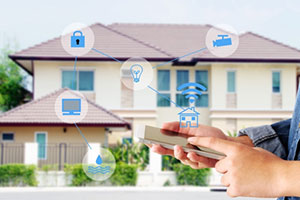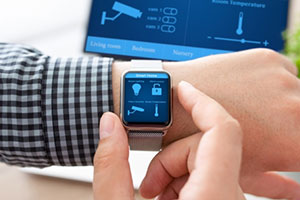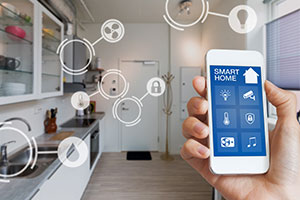by Anna Kucirkova
When we say “Smart Home,” your mind probably starts working a mile-a-minute. You probably imagine a Jetsons-like, technologically advanced home that responds to your every command.
While that concept is certainly understandable, smart homes in 2018 look less like auto-retracting walls and floors that automatically absorb messes and more like homes with convenient, easy-to-use home integration and home automation systems.
The practical uses of Smart Home automation and integration systems are much different than our sci-fi imaginations. And while you might think that Smart Home technology is simply a way to boost the wow-factor in your home, it can actually make your home life more efficient, more relaxed, and eliminate some elements of stress in your home.
In this article, we’re going to explain what home integration means, how you can make your home compatible, and why some versions of smart homes can be incredibly pragmatic. We’ve laid out costs, logical smart home devices, and reasons we believe that Smart Homes can be practical in 2018. 
If you’re looking for practical home automation that won’t break the bank, does more than just provide your home with the “cool factor” and can make your life easier, read on!
What is a Smart Home anyway?
It’s hard to set aside romantic, technologically-advanced ideas about what a futuristic smart home would be like, but what we’re referring to is really more of pragmatic home automation and integration system.
A home automation system is simply:
▪ A linked network of devices, appliances, and other items
▪ That are connected together
▪ To provide seamless control over all aspects of your home
Think about being able to control your washing machine, sound system, window treatments and thermostat all from your phone. That’s a Smart Home.
Everything is connected and communicates to the other connected items.
Coldwell Banker and the tech journal CNET teamed up to produce the following definition of a smart home:
A home that is equipped with network-connected products (i.e., “smart products,” connected via Wi-Fi, Bluetooth or similar protocols) for controlling, automating and optimizing functions such as temperature, lighting, security, safety or entertainment, either remotely by a phone, tablet, computer or a separate system within the home itself.
The home must have a smart security feature or a smart temperature feature in addition to a reliable internet connection. It then must include at least two features from a list of smart options, including appliances, entertainment, lighting, outdoor sensors, and safety detectors.
Smart Homes give you control, communication, comfort, and convenience, allowing you the options to control almost all aspects of how your home functions.
This includes things like:
▪ Adjusting the thermostat from an app on your phone
▪ Opening your blinds with a remote
▪ Closing doors with voice commands
▪ Arming your security system from your phone
▪ Closing doors with voice commands
Essentially, smart homes allow you to use digital devices to perform tasks that are traditionally done manually.
Window Shutters, Cloud Cams, Smart Bulbs, and more…
How you design your home automation system is entirely up to you. If you’re looking for impractical, cool-factor things, you can certainly build them into your home automation systems.
However, there are a few very practical home integration systems available on the market that are designed to simplify your life, save you money, and help your life move along at a smoother pace.
Amazon Cloud Cam
What kinds of devices? Consider products like the Amazon Cloud Cam. The Cloud Cam is one the most functional, practical, home automation tools. This security cam can provide a live feed of your home, protecting your family and belongings even when you’re not there, sending you motion notifications and free, 24-hour clip storage.
Somfy window shutters and roller shutters
Somfy allows you to motorize and automate blinds, shutters, awnings, solar screens, and much more. Once you’ve implemented Somfy’s system, you can control all these things with the touch of a button or even your voice.
Smart Bulbs
LED smart bulbs that you can place in your light fixtures and control with a remote allow you to easily control the light levels in your room.
The Smart Hub
A smart hub can be paired with a Smart Home app to automate, schedule, and control various elements of your home. Consider a smart hub like the Amazon Echo Speaker or the Wink 2. These speaker hubs allow you to vocally control most of your other home automation devices.
Want to control the thermostat? Give your speaker a holler. Want to dim the lights or shut the blinds? Let your speaker know.
If you’re not interested in a voice-controlled hub, consider a universal remote like the Logitech Harmony Elite. This remote connects to the Harmony Home Hub to control other bluetooth, wi-fi, and other infrared devices in your home.
Other examples include things like the Amazon Dash buttons, which allow you to reorder products with the push of a button. These buttons connect to your wifi network and immediately place an order with Amazon when you press the button.
Is a Smart Home actually practical?
Our answer to this complicated question? Absolutely. A Smart Home can be incredibly practical. Because the design and functionality is completely up to you, it can be as practical as you want it to be.
For example, there are numerous practical functions you can implement with home automation systems, such as:
▪ Automatically turning on the fan in the bathroom when the shower starts
▪ Automating the blinds to receive or block sunlight
▪ Alerting you to doors opening and closing
▪ Closing skylights when it begins to rain
Save on energy
You can also save significant amounts of energy by implementing home automation technology. Smart technology allows your home to act intuitively and automatically. Think about how your house heats up in the summer with the additional solar rays entering your home through your windows.
Adding motorized window treatments like retractable awnings, solar shades, and blinds that you can control through a smart hub allows you to set a specific schedule for the blinds to close, eliminating additional heat entering your home throughout the day.
Increase the value of your home
Adding home automation is also practical because it dramatically increases the value of your home. According to a study done by Coldwell Banker, about 64% of current buyers are interested in automation, and that number is expected to continually increase.
Improved security
More than that, implementing home automation can provide a much better, more advanced security system that works in your favor regardless of where you are. Smart surveillance cameras that you can control from anywhere via your smartphone allow you to view live footage of your home at any time.
You can use smart locks on your doors and windows, full control to your home’s security system from anywhere, and set up a combination of alerts that can keep you, your family, and your belongings safer than ever.
It’s also convenient and practical to have simplified control of your home at the touch of a button. Close all your shades at one time, set up scheduled feeding times for your animals, shut and lock your doors with the touch of a button. In an integrated Smart Home, you can experience customization and comfort on a practical level.
The Verdict: Smart Home tech can be perfectly practical
Home automation, home integration, and smart home tweaks for your house can be pretty cool, but more than that, they can be incredibly practical. Home integration features can help you to save costs on lighting and air conditioning, keep your home perfectly controlled, and even protect your home from intruders when you’re not there.
Sure, you can implement all the wow-factors if you’re looking to make your home as cool-as-can-be, but remember, there are always practical solutions in the form of security, light bulbs, voice automation, scheduling and timing mechanisms, and much, much more.

Add new comment